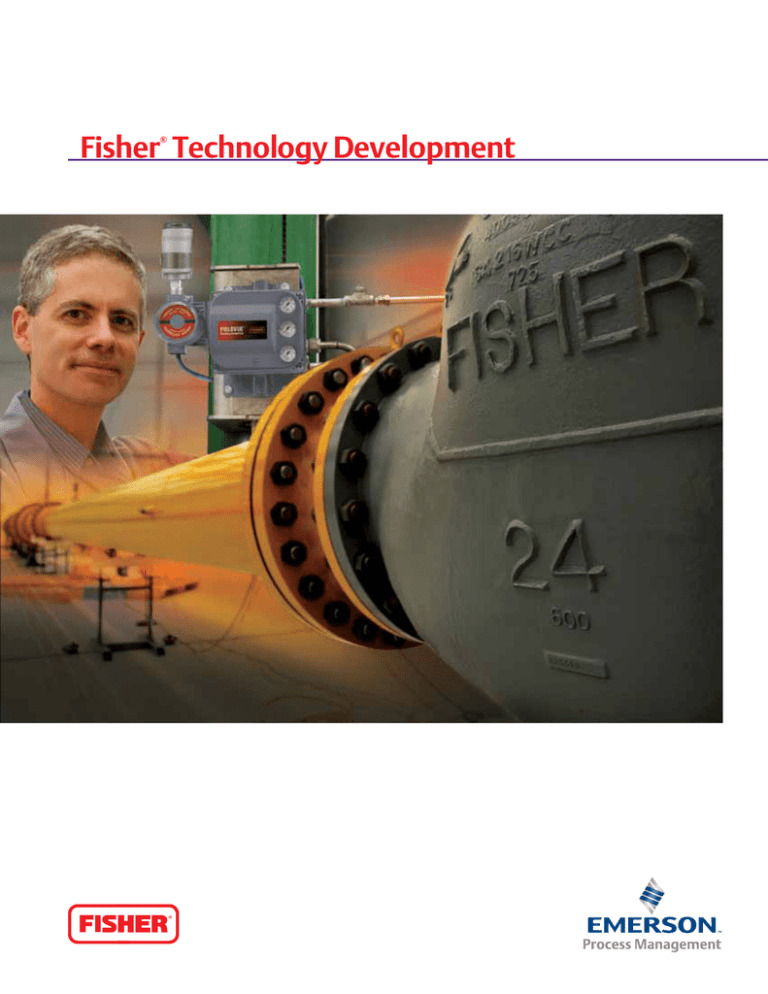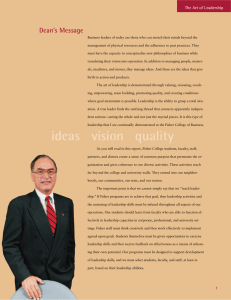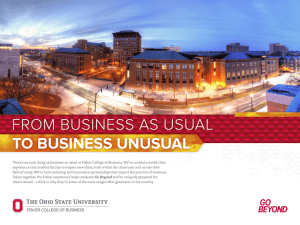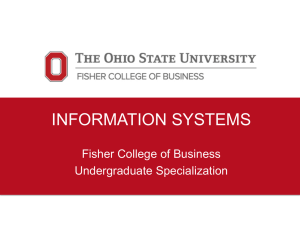
Fisher Technology Development
®
THE CONTROL VALVE YOU CHOOSE MATTERS
WHEN YOU HAVE TO ACHIEVE MORE EFFICIENT,
PRODUCTIVE, AND SAFER PLANT OPERATION.
The process industry is changing. Facilities are bigger and demand larger, highly engineered control valves for
more severe applications.
At Emerson, we have a staff of talented engineers who are passionate about developing Fisher® control valves
for the ever-changing process control industry. Our engineers were the:
nF
irst to develop the proven digital plant architecture, PlantWeb™.
nF
irst flow test lab in the process control industry.
nF
irst to develop authoritative capacity and sizing data charts.
nF
irst to use rotary valves as process control valves.
nF
irst to commercialize quick-change, cage-style trim.
nF
irst to develop aerodynamic noise prediction techniques and procedures.
nF
irst to receive N-stamp certification and to manufacture automatic control
valves for nuclear power plants.
nF
irst to develop digital valve controllers and performance diagnostics for
improved control and predictive maintenance.
nF
irst to develop special control valve sizing procedures for non-ideal fluids,
non-Newtonian fluids, and out-gassing fluids.
nF
irst to provide a method for customers and consulting engineers to accurately
predict plant noise generated by control valves.
nF
irst to provide dedicated material expertise in the industry.
We’re proud of our reputation for taking up challenges so that It’s Never Been Done Before simply becomes
Consider it Solved.
When you buy Fisher control valves, you get the applications experience that comes from over 130 years
of work in the industry. Plus you get the benefit from millions of dollars of research invested in solving the
issues important to you.
Fisher product specifications are, in many cases, more stringent than the industry accepted standards set
by regulatory agencies. Our attention to and evaluation of product quality is necessary to bring you Fisher
technologies of the highest reliability and performance.
Using Fisher technology is the best way to achieve efficient, productive, and safer plant operation and this can
be demonstrated by a visit to the Emerson Innovation Center for Fisher Technology.
Fisher® Technology Development | 3
QUALIFYING CASTINGS
GOING BEYOND CODES
Casting quality is frequently cited as a safety issue. Global
sourcing of castings has heightened customer awareness
and concern about the integrity of these castings.
Minimal stress on all features of a
pressure vessel greatly improves
fatigue life and therefore, safety.
Simply meeting minimum wall
thickness requirements is not
sufficient.
Emerson enforces a comprehensive quality specification for
its Fisher control valves that must be met by all suppliers of
pressure-containing and structural metal castings. These
requirements exceed those specified by ASME, ISO, and EN.
Emerson requires casting suppliers to submit all weld
procedures for approval to ensure they meet requirements
of ASME Section IX and Pressure Equipment Directive (PED).
In addition, samples must be submitted to the Emerson
materials lab for metals that are especially problematic to
cast and heat treat, such as duplex stainless steel and
high-nickel alloys.
Using advanced finite element
analysis (FEA) models, our engineers
analyze complex geometries in
control valve designs to locate stress
concentrations. A cross sectional
look at the finite element analysis
model of an actuator illustrates
areas of varying stress levels as
shown by the color gradient. Design
modifications to minimize stresses
can be quickly implemented before
prototyping or production tryouts.
In addition to meeting minimum
wall thickness specified in standards,
every Fisher structural design
undergoes a proof hydrostatic test
to verify that the stress does not
exceed the code allowable stress and
to validate the FEA model.
Fisher control
valves are used in
safety-critical areas
of nuclear power
plants and it is
imperative that they
work when called
upon. They undergo
rigorous qualification
testing to satisfy the
requirements of ASME
QME-1, IEEE382,
IEEE344, and IEEE323.
4 | Fisher® Technology Development
IMPROVING OPERATIONAL SAFETY
LIMITING EMISSIONS
Processes that involve toxic or highly flammable fluids rely
upon safety instrumented systems. Lack of knowledge
of valve position or operation threatens worker safety,
causes environmental concerns, and potentially damages
operating equipment.
Leaking chemicals and gases can be harmful to health and
to the environment. Accordingly, stringent regulations
are in place to control the amount of fugitive emissions
released into the atmosphere.
Emerson has developed digital valve controllers to meet
customers’ emergency shutdown requirements. As part of
the emergency shutdown valve package, the Fisher digital
valve controller enables automated partial stroke testing
while the valve remains online. Diagnostics reporting
provides automated pass/fail results, an audit trail, and
time stamp.
Fisher SIS digital valve controllers have been certified by
TÜV Product Services (Germany) to be in accordance with
IEC61508 for use in safety instrumented systems up to
safety integrity level 3.
In addition to SIS technologies, Fisher and TopWorx®
wireless position monitoring technologies provide
operators with the status of their valves. Position
monitoring enables safe startups and shutdowns, reduces
unintentional releases, and eliminates the need for visual
inspection.
Fisher control valve packing technologies ensure
compliance with standards and customer expectations.
These technologies offer excellent emission control
capabilities and were tested and certified by these
international certification organizations: Cetim
(ISO 15848-1 Class B), Yarmouth (FCI/ANSI 91-1), and
TÜV (TA-Luft).
The helium mass spectrometer counts each atom of helium
detected through the sniffer probe and calculates a leak
rate. For the Fisher control valve shown above, the total
accumulated leakage over one year would be equivalent to
a bubble the size of a golf ball.
Emerson has multiple packing technologies that are so
unique and novel that they are patented. Fisher packing
technologies are methodically developed with rigorous
test techniques. These are regarded by our customers as
best-in-class packing that not only comply with emissions
standards, but improve malodorous and harmful plant
environments.
Where zero emissions are required, Fisher bellows
technologies are available in corrosion-resistant materials.
Fisher® Technology Development | 5
QUIETING NOISE
DIAGNOSING CONTROL VALVES LOCALLY
Process plants require controlled noise levels to protect
employees. Reduced fenceline noise levels are also
necessary to maintain good relationships with adjacent,
populated areas.
Process equipment maintenance must be planned, yet it
is difficult to know which equipment needs maintenance.
Since control valves are the primary elements in the loop
that actually adjust the process, their performance is
fundamental.
Fisher noise attenuation technologies enable effective
noise-reducing control valves and provide installed
predicted noise levels consistently, for compliance with
regulatory limits.
Supported with a 4,738 m2 (51,000 ft2) facility and a
unique 2,415 m2 (26,000 ft2) sound chamber, Emerson
can accurately quantify noise from piping and vents. Test
programs are conducted on Fisher control valves, valve
trim, silencers, diffusers, and spargers as well as tees,
elbows, reducers, and expansions to determine their
contribution to overall noise.
Accelerometers and pressure transducers are used to
measure pipewall vibration and sound level.
Acoustics expertise is utilized at all stages, from product
development to application, quotation, and as-installed
performance. Experts are available to analyze the entire
plant environment and solve noise problems beyond the
control valve.
Since their introduction, Fisher digital valve controllers
have changed the way plants monitor control valves.
Features such as auto calibration; linkage-less, non-contact
feedback; and on-line performance diagnostics provide
unsurpassed real-time plant performance. More than 50
patents have been awarded for the product line.
Hazardous areas or hard-to-reach locations present barriers
to locally verifying proper control valve performance. In the
past, local diagnostics required technicians to use laptops in
the field.
Emerson mobile technology offers a solution to this
longstanding problem through the use of handheld field
communicators. This tool of choice for maintenance
technicians has been expanded to include control valve
diagnostics. Fisher application software allows the
extension of the technology to other handheld platforms,
such as PDAs and smartphones. Catwalks, ladders, or other
difficult locations no longer present a barrier to maintenance
technicians. Diagnostic tests can now be run with ease and
mobility.
6 | Fisher® Technology Development
PROTECTING COMPRESSORS
QUALIFYING MATERIALS
In order to operate more efficiently, liquefied natural gas
plants prefer to run turbo compressors close to the surge
limit line. The margin for error to avoid equipment damage
during surge events is very narrow.
Equipment constructed from a
material incompatible with the
process environment may damage
operating equipment or cause a
plant shutdown.
Antisurge valves must be responsive in order to protect
critical and costly compressors from damage during
transients. They also must be accurate to allow operation at
peak efficiency.
Technologies incorporated in Fisher antisurge valves are
unmatched by any other manufacturer. Fisher precision
actuation technology enables a full stroke up to 50.8 cm
(20 in) in less than one second and better than 1%
positioning accuracy for even very large control valves.
Setup and tuning can be performed remotely and in
minutes. Without Fisher technology it can take hours.
Factory acceptance testing to Fisher specification FGS 4L11
typically eliminates the need for any tuning changes after
installation.
Fisher digital valve controllers use special, antisurgespecific control and tuning algorithms for robust, stable,
high performance control.
The FGS 4L11 factory acceptance test is becoming an LNG
industry standard. This performance standard is being
applied to critical process control in all industries.
Fisher material technologies offer a
significant reliability improvement
over generic grades. Material
formulations are developed,
specified, and controlled for metals,
elastomers, and plastics in Fisher
control valves.
A fully-equipped materials lab is
staffed by Emerson technologists
who verify that materials
and coatings will perform to
expectations physically and
mechanically. If materials and
suppliers do not meet our stringent
standards, they are rejected.
Emerson technologists are industry
leaders, developing new global
standards and identifying new
materials that will solve difficult
customer problems. They are the
ones the industry turns to when
materials don’t perform as expected.
Elastomers are highly
documented as the
cause of downtime
in plants. Off-the-shelf
elastomers cannot
meet climate extremes
and require extensive
qualification. Dynamic
mechanical analysis
has been performed
on each Fisher
elastomer formulation
to investigate the high
and low temperature.
Fisher® Technology Development | 7
WITHSTANDING VIBRATION
MODERNIZING UNITS
High vibration from process plant operation can shorten
equipment service life, damage critical components, and
cause deterioration or total loss of control.
Stopping production and turning off profits in order to
modernize process units is not economically feasible.
Fisher control valves are designed and tested for robustness
in vibration applications. Emerson engineers qualify
products to industry vibration standards and then go
farther. For instance, Fisher products are subjected to
additional testing for millions of cycles at their resonant
(worst case) frequency to assure performance in your
process plant.
Fisher products, by design, are enhanced to improve
vibration robustness. Wear points are eliminated in Fisher
instrumentation with linkage-less, non-contact position
feedback. Integral mountings make brackets and external
tubing obsolete.
A hot cutover allows plants to switch to digital without
taking the process down. The ability of Fisher digital valve
controllers to function in two operating modes, pressure
and travel, has multiple benefits for hot cutovers. Fisher
digital valve controllers’ unique pressure control capability
keeps control valves at set point as you switch to digital
instrumentation.
Personnel can locate the digital valve controller on the
control valve, make a fieldbus connection, and configure
it to the pressure control mode to perform as a fieldbusto-pressure transducer, providing input to the existing
pneumatic positioner. Then, when the control room is
ready, the digital valve controller can be easily switched to
travel control, replacing the pneumatic positioner.
8 | Fisher® Technology Development
SURVIVING EXTREME
TEMPERATURES
Whether driven by process
temperatures or climate
extremes, control valves need
to operate as specified.
LNG control valves are tested
at cryogenic temperatures of
-196°C (-321°F).
REMOTE MOUNT
SOLUTIONS
A refinery valve used in
catalytic reforming is
tested at 704°C (1300°F).
Remote mount solutions for
instrumentation decouple the
electronics from the process
environment for extended
temperature range.
TROUBLESHOOTING
CONTROL VALVES
While control valves are
on-line and in service, Fisher
digital valve controllers
can detect, capture, and
trend more than 200 fault
conditions and provide
recommended actions.
HIGH CYCLE TESTING
The cycle life of Fisher control
valves is verified. To meet
Emerson’s pressure swing
adsorption quality standard,
cycle counts must exceed
one million.
Fisher® Technology Development | 9
REDUCING PROCESS VARIABILITY
REDUCING AIR OR GAS CONSUMPTION
Reducing process variability is key to improving product
quality. Excessive variability is the direct result of control
equipment—such as control valves—failing to achieve
required performance levels.
High consumption of compressed air or natural gas by
instruments means high energy costs for plants.
To minimize variability, Emerson engineers perform
comprehensive tests on complete control valve assemblies
during new product development. These control valve
assemblies are subjected to on-line, dynamic performance
testing to evaluate their ability to reduce variability. These
tests replicate how customers actually use control valves in
the field.
Fisher products have historically set the standard for
dynamic performance. Emerson is dedicated to continuous
improvement of existing products. New products must
exceed the performance of the products they replace.
Best-in-class flow lab facilities and control experts enable
us to meet these challenges.
Emerson engineers developed technology in the
instrument product line that reduces steady-state air or
gas consumption to 1/10th that of previous products for
significant energy and economic savings. This technology is
so novel that it is patented.
Emerson technologists use state-of-the-art analysis
tools and laboratories to maximize instrument control
performance while minimizing air consumption.
10 | Fisher® Technology Development
ACCURATE ENGINEERING
SPECIFICATION AND PROCUREMENT TIME
Sizing coefficients for Fisher control valves are based on
actual flow tests performed by Emerson engineers. It is not
necessary to apply conservative sizing practices; therefore,
project costs are reduced.
An ISA data sheet has 120 fields that must be agreed upon
between the control valve specifier, supplier, and end user.
Control valves are designed for each unique installation and
require an intense exchange of information.
Every Fisher control valve design undergoes thorough
and extensive flow testing. Test engineers determine
sizing coefficients, stem force or hydrodynamic torque
requirements, and investigate actual performance.
Fisher Specification Manager software helps you manage
your control valve specification data. It enables seamless
import/export data exchange with Intergraph’s SmartPlant
Instrumentation.®
Real processes often operate under conditions that are
beyond the scope of industry standards. Enhanced control
valve application technology has been developed that
helps ensure that correct valve sizes are specified for all
application conditions. Examples include non-ideal gases,
multi-phase flow, and out-gassing fluids. Correct valve
sizes help ensure safe and trouble-free operation, avoiding
adjustments during startup.
Test engineers operate three flow labs on three continents
giving Emerson engineers access to flow lines up to NPS 36
and 240 bar (3,500 psig).
Fisher® Technology Development | 11
INTEGRATION
INSTALLATION TIME AND COST
Emerson recognizes that process plants are interconnecting
products from different suppliers and that true interoperability
is essential.
Reduced installation time and cost
result in faster time to market. With
Fisher control valves, you will realize
significant savings.
Emerson tests different hardware and firmware versions of
Fisher control valves, digital valve controllers, and software
to assure no loss of functionality or data. Fisher products
are connected to various communication protocols,
automation systems, multiplexers, wireless gateways,
and Windows® operating systems. Testing a variety of
Fisher control valve and instrument revisions confirms that
current and legacy devices integrate properly into user
interface tools.
ndustry-leading wireless products
n I
can eliminate wiring all together.
nF
oundation™ fieldbus reduces field
wiring expense.
nR
ealize reduced commissioning
time with ease-of-use features
such as auto calibration and tuning
for Fisher digital valve controllers.
nF
isher digital valve controllers with
non-contact, linkage-less feedback
allow for reduced mounting and
calibration time.
nF
isher software allows commissioning of all control valves from the
maintenance engineer’s workstation.
actory acceptance testing
nF
documented by FGS 4L11 reduces
on-site tuning for compressor
control and other critical
applications.
Testing ensures
flexibility of control
valve installation
orientation. Fisher
rotary control valves
can be mounted in
either horizontal
or vertical position
without compromising
cycle life.
Fisher technology development
capabilities extend worldwide with
engineers and labs in North America,
Europe, and Asia. We have subject
matter expertise in the following
fields:
n Accelerated testing
n Acoustics
n Advanced modeling
n Codes and standards
n Control theory
n Design of experiments
n Embedded firmware design
n Fluid behavior and thermodynamics
n Low power electronics
n Materials
n Seismic analysis
n Statistics
n Structural analysis
n Test automation
n Vibration
n Wireless
WORLDWIDE LABS INCLUDE:
n Acoustics Lab
n Calibration Lab
n Cycle Test Lab
n Experimental Stress Analysis Lab
n Firmware Development Lab
n Flow Lab
n Hot Air Testing Lab
n Instrument Endurance Lab
n Instrument Environmental Lab
n Instrument Electronics Lab
n Instrument Firmware Test Lab
n Instrument Integration Test Lab
n Instrument Manufacturing Lab
n Instrument Marketing Lab
n Instrument Mechanical Lab
n Instrument Product Evaluation Lab
n Instrument Research Lab
n Instrument Technical Support Lab
n Instrument User Interface Lab
n Materials Lab
n Optimized Digital Valve Lab
n PlantWeb Demonstration Lab
n Performance Differentiation Lab
n Prototype Development Lab
n Seismic Lab
n Vent Testing Lab
n Vibration Lab
© Fisher Controls International LLC 2010 All Rights Reserved.
Fisher, PlantWeb, and TopWorx are marks owned by one of the companies in the Emerson Process Management
business division of Emerson Electric Co. Emerson Process Management, Emerson, and the Emerson logo are
trademarks and service marks of Emerson Electric Co. All other marks are the property of their respective
owners.
Emerson Process Management
Marshalltown, Iowa 50158 USA
Sorocaba, 18087 Brazil
Chatham, Kent ME4 4QZ UK
Dubai, United Arab Emirates
Singapore 128461 Singapore
www.EmersonProcess.com/Fisher
D351843X012 / H: / Nov10
The contents of this publication are presented for informational purposes only, and while every effort has
been made to ensure their accuracy they are not to be construed as warranties or guarantees, express
or implied, regarding the products or services described herein or their use or applicability. All sales are
governed by our terms and conditions, which are available upon request. We reserve the right to modify
or improve the designs or specifications of such products at any time without notice. Neither Emerson,
Emerson Process Management, nor any of their affiliated entities assumes responsibility for the selection,
use, or maintenance of any product. Responsibility for proper selection, use, and maintenance of any
product remains solely with the purchaser and end-user.




